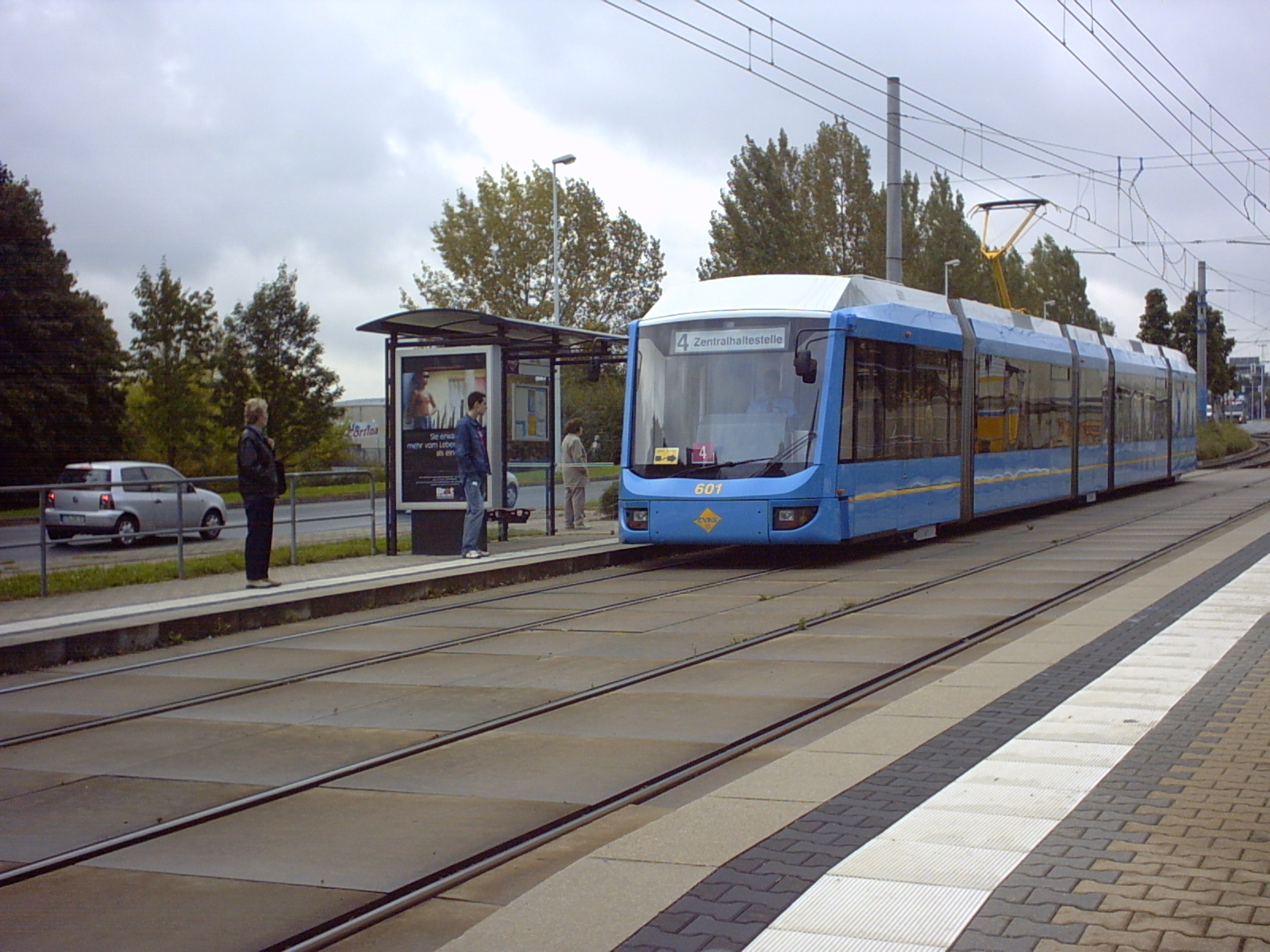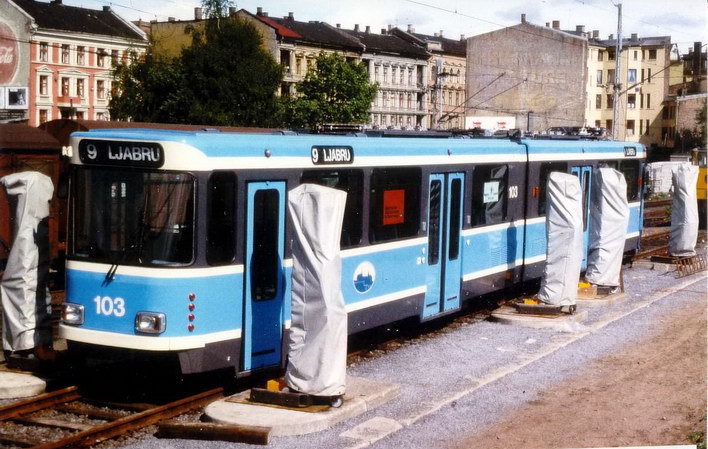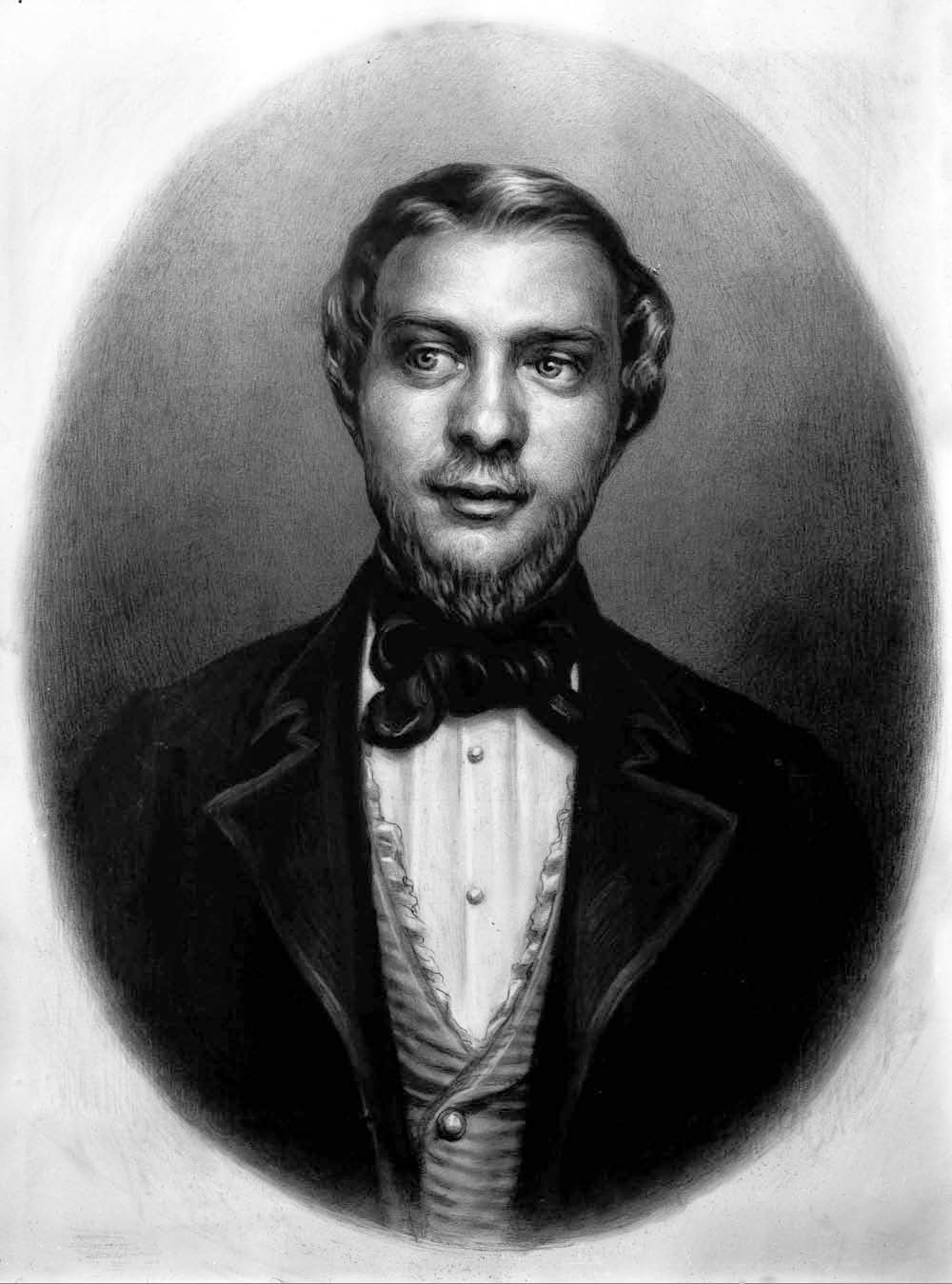|
SL95
SL95 is a series of 32 low-floor, articulated trams operated on the Oslo Tramway. The series was built by Italian rail manufacturer Ansaldo/ Firema, later known as AnsaldoBreda (now Hitachi Rail Italy), and delivered between 1999 and 2004. Capacity for the eight-axle, three-section vehicles is 212 passengers, of which 88 can be seated. The name derives from being ordered in 1995. Original plans called for the delivery to be between 1997 and 1998. Delivery took many years due to a magnitude of technical flaws, including high noise levels, freezing during the winter and corrosion. The trams are long, wide and tall. The aluminum vehicles weigh and have a power output of . The trams operate all services on lines 13, 17 and 18. Due to their heavy weight and large turning radius they are unsuitable for the other lines. However, they are the only bi-directional trams in the fleet, and are needed on lines 17 and 18 along the Ullevål Hageby Line. The trams cost about each, but disco ... [...More Info...] [...Related Items...] OR: [Wikipedia] [Google] [Baidu] |
SL79
SL79 is a class of 40 articulated trams operated by the Oslo Tramway of Norway. The trams were a variation of the Duewag trams that had been developed by the German manufacturer since the 1950s. The six-axle vehicles are unidirectional with four doors on the right side. The trams can seat 77 passengers three and four abreast, with an additional 91 people able to stand. Power output is , provided by two motors on the two end bogies, that supplement a central unpowered Jacobs bogie located under the articulation. The trams are long and wide. They are capable of and have standard gauge. They were built in two series, the first of 25 units delivered in 1982–84, and the second of 15 units delivered in 1989–90. The first 10 units were built by Duewag, while the last 30 were built in Norway by Strømmen. They were numbered 101 through 140. The two series vary slightly in specifications. The trams were ordered in 1979 after the 1977 decision to not close the tramway, after the SM5 ... [...More Info...] [...Related Items...] OR: [Wikipedia] [Google] [Baidu] |
Oslo Tramway
The Oslo tram network ( no, Trikken i Oslo, short from ', 'electric') is the tram system in Oslo, Norway. It consists of six lines with 99 stops and has a daily ridership of 132,000. It is operated by , a subsidiary of the municipally-owned who maintain the track and 72 tram vehicles on contracts with the public transport authority . The system operates on standard gauge and uses 750 V DC overhead. Depot, workshops and headquarters are at (at the terminus of lines 13 and 17). There is also a depot at (along lines 18 and 19) that is home to the technical company InfraPartner, which maintains the track for the tram and metro systems in Oslo, and a small office building for . History The first tram in Oslo was opened in 1875 with a short line between Homansbyen west of the city centre, Oslo West Railway Station and a sideline to Grønland, east of the city centre. The first "trams" were in fact horse-drawn vehicles on flanged steel wheels. The first expansion of the line came ... [...More Info...] [...Related Items...] OR: [Wikipedia] [Google] [Baidu] |
SM53
SM53, originally designed MBO and colloquially known as Høka, were a class of 58 trams and 50 trailers built by Høka and Hägglund for Oslo Sporveier. The units were used on the Norway's Oslo Tramway from 1952 until 2000. The long and wide trams weighed . They had four motors providing a combined power output of , allowing for a top speed of . The first series of thirty trams in 1950, with delivery in 1952 and 1953. These were designated MBO50. The next order was for new bodies for used Class SS units. The eight motor units were designated MO and nicknamed Chickens, while the twelve trailers were designated TO. These twin-axle units proved unsuccessful and Oslo Sporveier therefore took deliver of more MBO units. The next batch of twelve MBO55 units were delivered in 1957 and the final batch of eight were designated MBO56 and delivered in 1958. These were built for use on the Lambertseter Line, but were found unsuitable for use on light rail service and later moved back ... [...More Info...] [...Related Items...] OR: [Wikipedia] [Google] [Baidu] |
SM83
SM53, originally designed MBO and colloquially known as Høka, were a class of 58 trams and 50 trailers built by Høka and Hägglund for Oslo Sporveier. The units were used on the Norway's Oslo Tramway from 1952 until 2000. The long and wide trams weighed . They had four motors providing a combined power output of , allowing for a top speed of . The first series of thirty trams in 1950, with delivery in 1952 and 1953. These were designated MBO50. The next order was for new bodies for used Class SS units. The eight motor units were designated MO and nicknamed Chickens, while the twelve trailers were designated TO. These twin-axle units proved unsuccessful and Oslo Sporveier therefore took deliver of more MBO units. The next batch of twelve MBO55 units were delivered in 1957 and the final batch of eight were designated MBO56 and delivered in 1958. These were built for use on the Lambertseter Line, but were found unsuitable for use on light rail service and later moved back to ... [...More Info...] [...Related Items...] OR: [Wikipedia] [Google] [Baidu] |
Lilleaker Line
The Lilleaker Line ( no, Lilleakerbanen) is a suburban tramway from Skøyen in Oslo westwards to Jar, Bærum in Norway. It is operated by Line 13 from Ljabru to Bekkestua of the Oslo Tramway, operated by Oslo Sporvognsdrift. The line continues on the Oslo Metro west of Jar as part of the Kolsås Line, and as a street tramway on the Oslo tramway system at Skøyen as the Skøyen Line. Route The Lilleaker Line runs from Skøyen to Jar. The line is a standard gauge, double track light rail line with 750 volt overhead wire. At Skøyen it connects with the Skøyen Line of the Oslo Tramway and at Jar to the Kolsås Line of the Oslo Metro. Most of the route is dominated by housing. At Skøyen, there is a short walk to Skøyen Station on the mainline Drammen Line. It serves all west-bound trains of the Oslo Commuter Rail, some regional trains and the Airport Express Train. The station is also an important bus hub serving several routes. The route continues via Hoff and Abbdedie ... [...More Info...] [...Related Items...] OR: [Wikipedia] [Google] [Baidu] |
Kolsås Line
The Kolsås Line ( no, Kolsåsbanen) is a line of the Oslo Metro. It branches off from the Røa Line at Smestad Station and runs through western Oslo and Bærum to Kolsås Station. It serves the neighborhoods of Ullernåsen, Øraker, Jar, Bekkestua, Haslum, Gjettum and Kolsås. It is served by Line 3 of the metro at a 15-minute headway. The section from Jar to Bekkestua is built as a dual system with overhead wires, allowing Line 13 of the Oslo Tramway to continue from the Lilleaker Line to Bekkestua every ten minutes. The Kolsås Line was built as an extension of the Lilleaker Line. It had been built to Lilleaker in 1919. The line was extended to Avløs on 1 July 1924, and the line was extended to Kolsås on 1 January 1930. The line was initially owned by Bærumsbanen, which was bought by Oslo Sporveier in 1934. A connection to the Røa Line opened on 15 June 1942, allowing the line access to the Common Tunnel. At this point the section from Sørbyhaugen to Kolsås was ... [...More Info...] [...Related Items...] OR: [Wikipedia] [Google] [Baidu] |
Hitachi Rail Italy
Hitachi Rail Italy S.p.A. is a multinational rolling stock manufacturer company based in Pistoia, Italy. Formerly AnsaldoBreda S.p.A., a subsidiary of state-owned Finmeccanica, the company was sold in 2015 to Hitachi Rail of Japan. After the deal was finalized, the current name was adapted in November 2015 to reflect the new ownership. History Early history: Ansaldo and Breda Ansaldo In 1853, the company '' Gio. Ansaldo & C.'' was registered in Genoa as a manufacturer of steam locomotives, rail rolling stock and steam engines. The company was backed by Camillo Benso, Count of Cavour, the powerful finance minister of Piedmont-Sardinia, who aimed to reduce its dependence on imported trains and rolling stock. Ansaldo entered the age of the steam locomotive in 1854 with its model FS113, also known as ''Sampierdarena''. During the First world war, Ansaldo became a large supplier of weapons to the Italian army; facing insurmountable difficulties with post-war reconversion to civi ... [...More Info...] [...Related Items...] OR: [Wikipedia] [Google] [Baidu] |
Ullevål Hageby Line
The Ullevål Hageby Line ( no, Ullevål Hageby-linjen) is a light rail section of the Oslo Tramway. It runs from Stortorvet in the city center of Oslo, Norway to Rikshospitalet. It passes through the areas of St. Hanshaugen, Ullevål Hageby and Blindern before reaching Gaustad. It serves major institutions such as Oslo University College, Bislett Stadion, Ullevål University Hospital, the University of Oslo and Rikshospitalet. The line is served by route 17 and 18 by Oslo Sporvognsdrift using SL95 trams, while the tracks are owned by Kollektivtransportproduksjon. The first section, from Stortorvet from Homansbyen, opened in 1875 as a horsecar line. It was electrified in 1900, and extended to Adamstuen in 1909. In 1925, the line reached Ullevål Hageby. The final extension to Rikshospitalet was opened in 1999, following the move of the hospital. The last section is formally called the Gaustad Line (''Gaustadlinjen''). North of Adamstuen, the line runs in its own right-of-way ... [...More Info...] [...Related Items...] OR: [Wikipedia] [Google] [Baidu] |
Low-floor Tram
A low-floor tram is a tram that has no stairsteps between one or more entrances and part or all of the passenger cabin. The low-floor design improves the accessibility of the tram for the public, and also may provide larger windows and more airspace. An accessible platform-level floor in a tram can be achieved either by using a high-floor vehicle serving high-platform tram stops, or with a true low-floor vehicle interfacing with curb level stops. Currently both types are in use, depending on the station platform infrastructure in existing rail systems. Some systems may make use of former railway alignments where use of existing high platforms is desirable, while others, particularly new systems, may not have the space to site high-level stops in urban centres. Low-floor tram configurations Trams traditionally had high floors, and these designs evolved into the tram with a low-floor centre section. Examples of this design are Amsterdam 11g/12g-trams and the Kusttrams in Belgium ... [...More Info...] [...Related Items...] OR: [Wikipedia] [Google] [Baidu] |
Lilleaker (station)
Lilleaker is a light rail station on the Oslo Tramway. Located at Lilleaker in Ullern, it was the terminus of the Lilleaker Line when it was opened in 1919 by Kristiania Elektriske Sporvei as an extension of the Skøyen Line (''Øraker'' was the original name). In 1924 the Lilleaker Line was extended twice into Bærum, first to Bekkestua and then to Avløs. During the schedule, SL95 trams operate the entire line 13 without any transfers needed. When a balloon loop was constructed at Lilleaker the single-directional trams could turn there. From 1 December 2010, the line 13 doesn't have its terminus at Lilleaker´. After extensive work with the Metro/Tram tracks at Jar the Lilleaker Line terminates at Bekkestua. At peak hours every second tram is a SL79 SL79 is a class of 40 articulated trams operated by the Oslo Tramway of Norway. The trams were a variation of the Duewag trams that had been developed by the German manufacturer since the 1950s. The six-axle vehicles are u ... [...More Info...] [...Related Items...] OR: [Wikipedia] [Google] [Baidu] |
Bekkestua (station)
Bekkestua is a station and tram stop that is served both by Oslo Metro on Kolsås Line and Oslo Tramway on Lilleaker Line situated at Bekkestua in Bærum, Norway. It is the terminus of the Lilleaker Line for tramway. Located between Ringstabekk and Gjønnes, it was reopened on 15 August 2011 after being closed on 1 July 2006. Between 1 July 2003 and November 2004, Bekkestua was the end station on the Kolsås Line. For a while the station was only being served by the Oslo Tramway line 13, while the station was closed for an upgrade. Since 2 December 2007, tram operations (on line 13) have returned on this line from Lilleaker to Bekkestua. Operations beyond Lilleaker use SL95 trams as there is no turnback loop at Bekkestua. The tram operations were discontinued in 2009, but reopened in January 2014 after technical difficulties delayed the opening by one month. Bekkestua bus terminal is only a minute's walk from the metro and tram platforms (1, 2, 3). Bus transfers (bus termin ... [...More Info...] [...Related Items...] OR: [Wikipedia] [Google] [Baidu] |
SM91
SM91 is the Norwegian designation for a tram type which operated on the Oslo Tramway until 2002. The trams were imported from Sweden, where they had originally run on the Gothenburg Tramway under the designation M25. The trams were originally delivered to the Gothenburg Tramway between 1958 and 1961. A total of 36 trams were eventually exported to Oslo, Norway, numbered 264 to 299. History 125 trams were built by Hägglund for Göteborgs Spårvägar, where they were designated M25 and given the serial numbers 501–625. They were built between 1958 and 1962. Following the decision to change from left to right-side driving on Dagen H on 3 September 1967, the tram company ordered an additional 130 trams in the M28 and M29 series. The M25s were then sent back to Hägglunds to be converted to right-hand driving, with doors on both sides. Two trams were then driven back-to-back, and the direction of the trams could simply be reversed on Dagen H. Oslo In the early 1990s, the Ring 3 ... [...More Info...] [...Related Items...] OR: [Wikipedia] [Google] [Baidu] |







